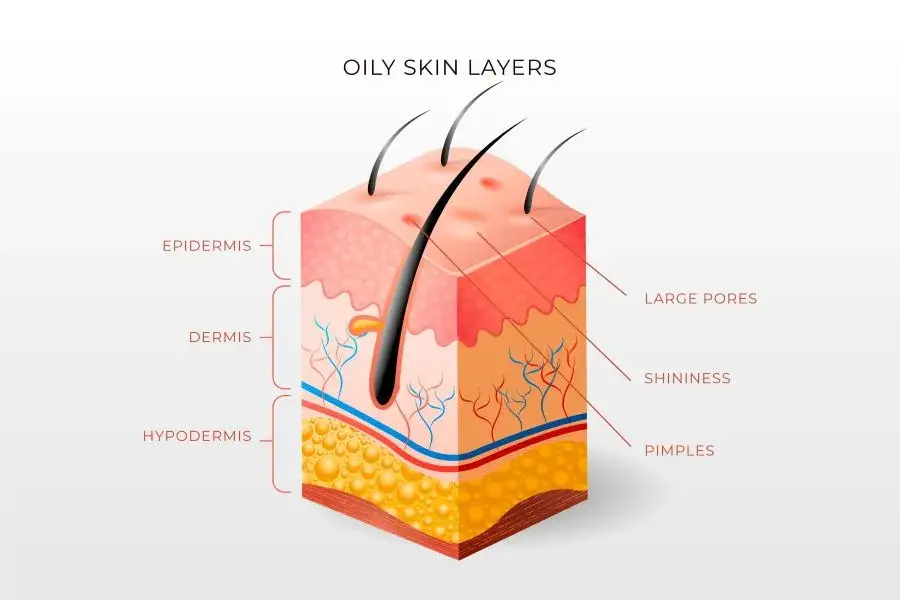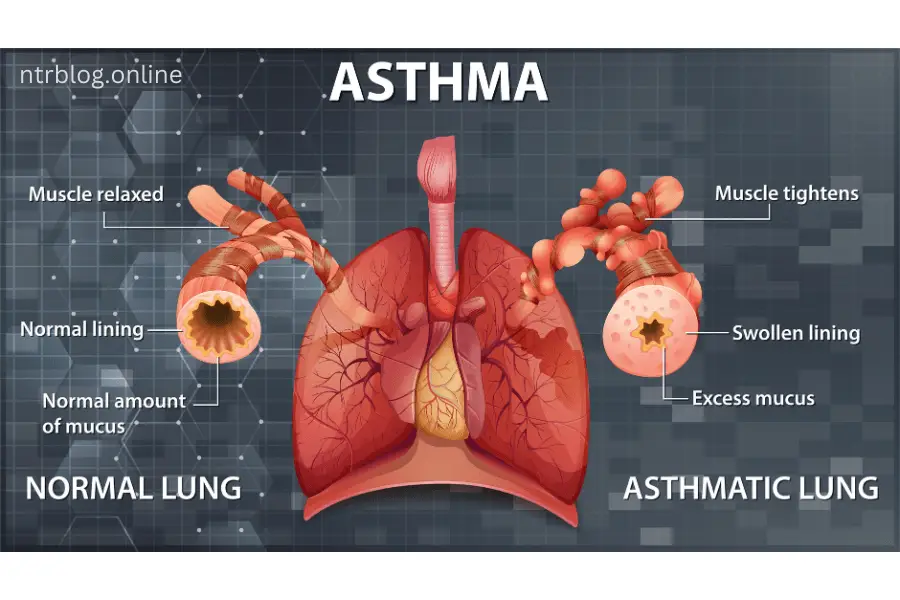- Functioning as the largest and most versatile organ of the body, the skin is a complex shell that plays a myriad of important roles. Made up of water, proteins, fats and minerals, this fantastic organ stands as a front-line defender against germs, a regulator of body temperature and an aid to tactile sensations
Table of Contents
Overview:
To understand the composition of the skin:
- The skin is a dynamic interaction of different layers, the primary components of which are epidermis, dermis and hypodermis. Each layer contributes in unique ways to the overall functioning of this complex organ. Beyond the physical structure, the skin is a major component of the internal system—a comprehensive network that includes not only skin but also hair, nails, oil glands, and sweat glands

Protective role of skin:
- Functionally, the skin acts as a strong protective barrier, protecting the body from the entry of harmful diseases and external threats. Furthermore, the complex network of nerves within the skin gives individuals the ability to perceive temperature variances and other sensations, allowing the body to effectively respond to environmental changes
Susceptible to challenges:
- Despite its resilience, skin is susceptible to a spectrum of challenges from acne, wrinkles and other common issues to more serious concerns like skin cancer, a vulnerability that underscores the importance of understanding and caring for skin in recognition of its vital role in maintaining overall health
- In essence, the skin is not just a superficial covering but a dynamic and indispensable organ that deserves attention and care. Exploring its complexities unveils a world of interconnected functions, emphasizing the importance of nurturing and protecting this complex armor for the benefit of the entire body.
Anatomy of the skin:
Understanding the layers of skin:
- The skin, a multifaceted organ, consists of three crucial layers, each contributing uniquely to its structure and functionality:
- 1.Epidermis (Top Layer): This visible and tactile layer is mainly composed of skin cells containing the protein keratin. The epidermis acts as a strong protective barrier, protecting against infections and environmental elements, and regulates skin color through melanin.
- 2. Dermis (middle layer): With 90% of the skin thickness skin is the major layer with an array of functions. It contains collagen and elastin, proteins that provide strength, elasticity and flexibility to the skin. In addition, tanning supports hair growth, facilitates sensory perception, produces oil, releases sweat, and ensures healthy nutrient supply through the blood vessels
- 3. Hypodermis (Bottom Layer): The hypodermis, also known as the fat layer, acts as a cushion for muscles and bones, protecting them from injury This skin layer is the connective tissue of muscles and bones, and plays a role through its insulating properties of body temperature In regulations.
Functions of each skin layer:
Epidermal function:
- Protective Barrier: A shield against bacteria, germs, and environmental elements.
- Skin Renewal: Continually produces new skin cells, replacing old cells every 30 days.
- Immune support: The Langerhans cells of the epidermis contribute to the body’s immune system, which helps fight germs and infection.
- Skin pigmentation: Contains melanin, which determines the color of skin, hair and eyes.
Dermatology Functions:
- Structural Support: The thickness of the skin provides structural integrity.
- Collagen and Elastin: Collagen strengthens skin cells, and elastin maintains flexibility and shape.
- Hair Growth: Supports the roots of the hair follicle.
- Sensory perception Cutaneous nerves enable the perception of temperature, touch and pain.
- Oil Production: Oil glands make the skin soft and smooth.
- Regulation of sweat: The sweat glands release sweat to regulate body temperature.
- Blood supply: Blood vessels supply nutrients to maintain healthy skin layers.
Hypodermis Functions:
- Cushioning: Protects muscles and bones from injury.
- Connective tissue: connects the skin layer with muscles and bones.
- Nerve and Vascular Support: Extended nerves and blood vessels provide connection facilities with the rest of the body.
- Temperature regulation: Insulates against extreme temperatures, preventing overheating or excessive cooling.
Extra fascinating skin facts:
- One inch of skin contains about 19 million skin cells, 60,000 melanocytes (cells that produce melanin), 1,000 nerve endings and 20 blood vessels
- Exploring the complex layers and functions of the skin offers the wonder of this dynamic organ, demonstrating its flexibility, adaptability and indispensable role in maintaining overall health.
Navigating Skin Conditions and Prioritizing Care:
Skin’s Conditions and Disorders:
- As the body’s frontline defender, the skin is susceptible to a myriad of conditions and disorders, including:
- Allergies : Such as contact dermatitis and rashes from plants like poison ivy.
- Blisters: Commonly caused by friction, burns, or certain medical conditions.
- Bug Bites: Including spider bites, tick bites, and mosquito bites.
- Skin Cancer: Encompassing various types, with melanoma being a significant concern.
- Skin Infections: Such as cellulitis, involving bacterial infection of the skin.
- Skin Rashes and Dry Skin: Common issues affecting skin health.
- Skin Disorders: Including acne, eczema, psoriasis, and vitiligo.
- Skin Lesions: Moles, freckles, and skin tags.
- Wounds, Burns, and Scars: Resulting from injuries or exposure to environmental factors.
Prioritizing Skin Care:
- The aging process, coupled with external factors, can impact the health and appearance of the skin. While some aspects of aging are inevitable, adopting a proactive approach to skincare can contribute to healthier skin. Consider the following practices:
- 1.Sunscreen Application: Use a broad-spectrum sunscreen with SPF 30 or higher, even if you spend most of your time indoors, to protect against harmful UV rays.
- 2. Avoid Tanning: Both indoor and outdoor tanning can lead to skin damage, premature aging, and an increased risk of skin cancer.
- 3. Stress Management: Find healthy ways to manage stress, as stress can exacerbate certain skin conditions.
- 4. Regular Skin Checks: Perform routine checks for changes in moles and skin, which may be indicative of skin cancer.
- 5. Quit Smoking: Smoking and tobacco use accelerate skin aging, so quitting can contribute to healthier skin.
- 6. Gentle Cleansing: Use mild cleansers for your face in the morning and at night to avoid skin irritation.
- 7. Hygiene Practices: Regular showers and the application of moisturizing lotion can help prevent dry skin.
- By incorporating these habits into your routine, you can promote the overall health and resilience of your skin, contributing to a vibrant and well-nurtured complexion.
Conclusion: Skin health guidance:
- In this exploration of skin health, we have uncovered the complexities of the body’s largest organ. From its critical role as a protective barrier to its involvement in temperature regulation, sensation and immunity, skin plays a dynamic part in our overall wellbeing
- Understanding its layers—epidermis, dermis, and hypodermis—reveals a harmonious synergy, demonstrating the versatility of skin. The epidermis shields and renews, the skin provides structural support and sensory perception, while the hypodermis cushions and regulates temperature
- Common questions underscore the importance of timely treatment for mole changes, rashes, or signs of infection. The alert communicating skin encourages us to seek care when we need it.
- Proactive skin care measures—daily sunscreen, stress management, and vigilant monitoring—highlight the interrelationship of overall wellness with skin health Embracing mindfulness empowers us to nurture and protect this fantastic organ for a vibrant and resilient journey through life.

Address common questions about skin health
Q: When should I talk to a doctor?
A: See your health care provider if you experience:
– Changes in the shape, color, shape, or symmetry of the mole.
– Development of new moles.
– Cuts that cannot be closed with housekeeping (may require stitching).
– Acute, blistering rash.
– Signs of a skin infection such as red lines or yellow discharge.
– Unexplained skin rash or skin condition.
Q: What is skin?
A: Skin, the largest organ of the body, serves as an important protective barrier between internal organs and the external environment. Consisting of many layers—epidermis (outermost layer), skin (middle layer), and subcutaneous tissue (inner layer) it regulates body temperature, protects against pathogens, and provides sensory information Contribute to skin sensation, thermoregulation, and immunity with hair follicles, sweat glands, blood vessels, and nerve endings gives
Q: How many layers of skin are there?
A: There are three main layers of skin:
1. Epidermis: The outermost layer, forms a protective barrier with cells producing keratin for strength and waterproofing.
2. Skin(dermis): This thicker layer beneath the epidermis contains blood vessels, nerve endings, sweat glands and hair follicles to provide support and nourishment
3. Subcutaneous Tissue (Hypodermis): An inner layer composed mainly of fat and connective tissues acts as insulation, regulates temperature and cushions organs These layers together are important for protection, sensation, temperature regulation, synthesis of essential substances including vitamin D They do the works.


